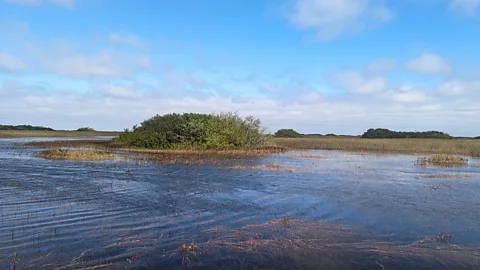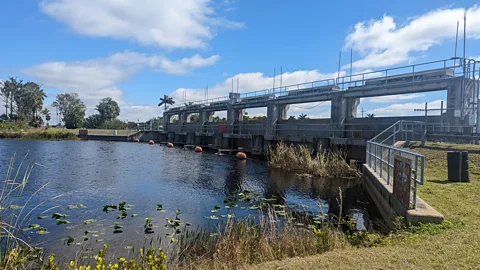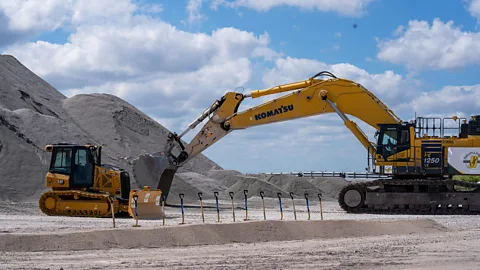Florida is building the world's largest environmental restoration project
 Lucy Sherriff
Lucy SherriffFlorida is embarking on an ambitious ecological restoration project in the Everglades: building a reservoir large enough to secure the state's water supply.
In February 2023, a large digger broke ground on a multi-billion dollar project that has been decades in the making: building a reservoir the size of Manhattan Island.
The reservoir, which is part of an historic restoration of the Everglades ecosystem, is intended to help bring a secure, long-term supply of clean drinking water to Florida's residents.
The Everglades Agricultural Area (EAA) reservoir will be located south of Lake Okeechobee, the largest freshwater lake in Florida, and conservationists have dubbed the project "the crown jewel" of the Everglades' restoration.
"It is the single most important project to store, clean and send water from Lake Okeechobee to nourish the Everglades and supply clean drinking water to millions in South Florida," Meenakshi Chabba tells BBC Future Planet. Chabba is an ecosystem scientist at the Everglades Foundation, one of the non-profit organisations that advocated for the project.
As well as protecting the drinking water of South Floridians, the reservoir is also intended to dramatically reduce the algae-causing discharges that have previously shut down beaches and caused mass fish die-offs. (Read more about the pollution causing harmful algal blooms).
Bigger than Manhattan and Staten Island combined, the reservoir will stretch over 10,100 acres large (4,090 ha), and, in addition, have a 6,500-acre (2,630-ha) stormwater treatment area. It will be able to store 78 billion gallons (295.2 billion litres) of water – enough to fill 118,000 Olympic-sized swimming pools.
"The water will help recharge the aquifer that provides drinking water to millions of people in South Florida," says Jason Schultz, a spokesperson for the South Florida Water Management District (SFWMD).
The reservoir, a t project between the US Army Corps of Engineers and the SFMD, is a small cog in a large initiative to restore the Everglades. The multi-billion dollar Comprehensive Everglades Restoration Plan was ed by Congress in 2000, and includes 68 infrastructure projects across Florida. The Everglades Foundation tells the BBC the restoration plan is the "largest environmental restoration project" in the world.
The infrastructure projects range from rehydrating carbon-sequestering wetlands, to building a complex network of stormwater treatment areas, smaller reservoirs and water control structures – and they're at varying stages of completion. The whole project is due to be completed in 2029.
A shortage of drinking water
The Everglades provides one out of three Floridians with their drinking water. The ecosystem recharges the water supply for all of South Florida – a population approaching nine million. South Florida's primary source of drinking water comes from groundwater stored in aquifers, mainly the Biscayne Aquifer, which is replenished by the Everglades.
 Lucy Sherriff
Lucy SherriffThe state's water supply has been put under immense pressure due to rapid population growth. Between 2020 and 2040, the population is expected to grow by 23% (4.8 million people) to 26.4 million while water demands are expected to increase by 13%. It's the nation's second fastest growing state.
In 2021, the Florida Department of Environmental Protection concluded in its annual water supply report: "Florida's current fresh water supply is projected to be unable to meet all of the growing needs of Floridians in the future without the development of alternative water supply projects".
In Miami-Dade County, the most populous in Florida, the Biscayne Aquifer is the primary source of drinking water. Due to sea level rise, the aquifer is vulnerable to saltwater intrusion, threatening contamination of the water supply. To protect its drinking water, the county is restoring canal systems and installing salinity control structures – gates which help separate fresh water and saltwater. Mangrove forests are being restored too, because they help slow the movement of saltwater through canals, keeping the water behind the gates fresher.
Although Florida receives ample rainfall – flooding is one of the state's top hazards – the ecosystem's natural water filtration systems have also been heavily altered and polluted by humans, Chabba explains, meaning Florida is still facing water shortage issues.
Chabba believes that the restoration plan will help protect the state's supply. "The freshwater flowing across the Everglades recharges Biscayne Aquifer, which provides drinking water to millions of South Florida residents," she says.
"Increasing freshwater inputs through restoration has the potential to slow down the impacts of saltwater intrusion into our vulnerable water supply."
 Getty Images
Getty ImagesAssefa Melesse, professor at the Institute of Environment at Florida International University, says the reservoir can benefit the drinking water supply indirectly and directly, as well as potentially reducing pressure on other water sources during dry periods. But, Melesse notes, "rising sea levels and changing rainfall patterns could affect the project's long-term effectiveness". When it comes to safeguarding Florida's drinking water supply, saltwater intrusion is a bigger problem than replenishing groundwater, says Barry Rosen, a professor of ecology and environment at Florida Gulf Coast University specialising in algal blooms.
"This intrusion is a really big deal," he says, "because the entire ecosystem is a leaky system. It's an extremely delicate balance between drinking water and flood control." If the Everglades system is dehydrated, more saltwater can intrude, Rosen says. But too much freshwater in the ecosystem and there's issues with flooding.
A 'significant challenge'
The reservoir is designed to move clean water south to nourish the Everglades, says the SFWMD, as well as reducing algal blooms and replenishing Florida's aquifers – where the drinking water is pulled from.
But Rosen is sceptical of just how much difference the reservoir will make, saying modelling how the reservoir will work is one thing, but the reality could be entirely different.
Florida receives around 51in (130cm) of rain annually. Around 38in (97cm) evaporates or runs off the land into surface waters – lakes, rivers and streams – leaving 13in (33cm) on average to recharge aquifers.
"You want to put the water in [the reservoir] when it's available to store it," Rosen continues, "so, when it's raining. But will it have the capacity we want every single year to store water? Is it going to be full certain years? To think that we'll just have an empty reservoir sitting there waiting for rain is unlikely."
Rosen also notes that it's possible the reservoir itself might become home to an algae bloom. "What is the water then usable for">window._taboola = window._taboola || []; _taboola.push({ mode: 'alternating-thumbnails-a', container: 'taboola-below-article', placement: 'Below Article', target_type: 'mix' });
